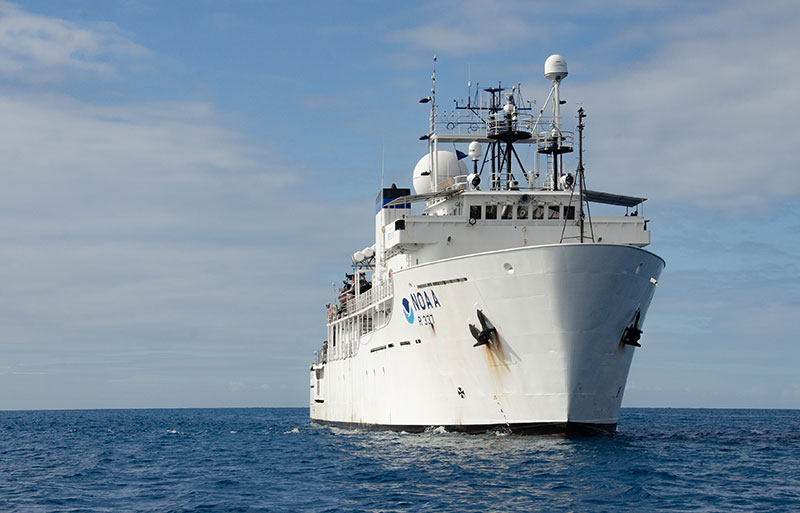About NOAA Ship Okeanos Explorer

NOAA Ship Okeanos Explorer is the only federal vessel dedicated to exploring our largely unknown ocean for the purpose of discovery and the advancement of knowledge about the ocean. The ship is operated by the NOAA Commissioned Officer Corps and civilians as part of NOAA's fleet managed by NOAA's Office of Marine and Aviation Operations. NOAA Ocean Exploration owns the mission equipment used during expeditions on Okeanos Explorer and coordinates the ship’s exploratory mission. The exploration remotely operated vehicles are operated via a partnership with NOAA Ocean Exploration and the Global Foundation for Ocean Exploration .
Missions of the 224-foot vessel include mapping, site characterization, reconnaissance, advancing technology, education, and outreach—all focused on understanding, managing, and protecting our ocean. Expeditions on the ship are planned collaboratively, with input from partners and stakeholders, and with the goal of providing data that will benefit NOAA, the scientific community, and the public.
During Okeanos Explorer expeditions, data are collected using a variety of advanced technologies to explore and characterize unknown or poorly known deepwater ocean areas, features, and phenomena at depths ranging from 250 to 6,000 meters (820 to 19,700 feet). The ship is equipped with four different types of mapping sonars that collect high-resolution data about the seafloor and the water column, a dual-body remotely operated vehicle (ROV) capable of diving to depths of 6,000 meters, and a suite of other instruments to help characterize the deep ocean. Expeditions typically consist of either 24-hour mapping operations or a combination of daytime ROV dives and overnight mapping operations.

NOAA Ship Okeanos Explorer at sea during the 2022 Caribbean Mapping expedition. Image courtesy of Anna Sagatov, GFOE, 2022 Caribbean Mapping. Download larger version (jpg, 5.1 MB).

NOAA Ship Okeanos Explorer in Pascagoula, Mississippi, at night during the Gulf of America 2018 expedition. Image courtesy of Caitlin Bailey, GFOE, Gulf of America 2018. Download larger version (jpg, 5.5 MB).
Unlike many other ocean expeditions supported by NOAA, most of the scientists participating in expeditions on Okeanos Explorer remain on shore, thanks to telepresence technology. The ship is equipped with a high-bandwidth satellite communications system capable of transmitting mapping and oceanographic data and real-time, high-definition video feeds from the ROV through network connections to scientists on shore. Using this technology, a theoretically unlimited number of scientists on shore are able to add their expertise to expeditions no matter where in the world the ship, or the scientists, are located.
Simultaneously, public viewers can tune in online to watch and listen to ongoing expeditions, bringing the excitement of ocean exploration and discoveries into classrooms, newsrooms, and homes—to anyone who has an internet connection and a passion for learning about the ocean.
Video courtesy of the NOAA Office of Ocean Exploration and Research, Gulf of America 2018. Download larger version (mp4, 151.2 MB).
Since being commissioned in 2008, NOAA Ship Okeanos Explorer has traveled the globe, exploring everywhere from the Indonesian “Coral Triangle Region” and benthic environments in the Galápagos, to areas in the Gulf of America, canyons and seamounts off the Northeast U.S. Atlantic coast, deep waters off Alaska, and marine protected areas within the Pacific. By collecting baseline information in never-before-explored areas, Okeanos Explorer expeditions further our knowledge while setting the stage for future in-depth exploration activities.
Prior to being obtained by NOAA in 2004 and commissioned in 2008, Okeanos Explorer operated as the U.S. Naval Ship Capable, a T-AGOS class vessel. The ship was named by students from Illinois’ Woodstock High School in a nationwide ship-naming contest; in ancient Greek cosmology, Okeanos was the river/ocean that encircled the world.
The ship is homeported in Newport, Rhode Island, and conducts operations around the globe.
For additional information, For a more-detailed and technical overview of the exploration capabilities on Okeanos Explorer, see the following fact sheets: Ocean Exploration Capabilities of NOAA Ship Okeanos Explorer (pdf, 8.1 MB) and Remotely Operated Vehicles: Deep Discoverer and Seirios (pdf, 1.4 MB).